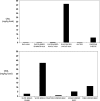Does accumulation of advanced glycation end products contribute to the aging phenotype?
- PMID: 20478906
- PMCID: PMC2920582
- DOI: 10.1093/gerona/glq074
Does accumulation of advanced glycation end products contribute to the aging phenotype?
Abstract
Background: Aging is a complex multifactorial process characterized by accumulation of deleterious changes in cells and tissues, progressive deterioration of structural integrity and physiological function across multiple organ systems, and increased risk of death.
Methods: We conducted a review of the scientific literature on the relationship of advanced glycation end products (AGEs) with aging. AGEs are a heterogeneous group of bioactive molecules that are formed by the nonenzymatic glycation of proteins, lipids, and nucleic acids.
Results: Humans are exposed to AGEs produced in the body, especially in individuals with abnormal glucose metabolism, and AGEs ingested in foods. AGEs cause widespread damage to tissues through upregulation of inflammation and cross-linking of collagen and other proteins. AGEs have been shown to adversely affect virtually all cells, tissues, and organ systems. Recent epidemiological studies demonstrate that elevated circulating AGEs are associated with increased risk of developing many chronic diseases that disproportionally affect older individuals.
Conclusions: Based on these data, we propose that accumulation of AGEs accelerate the multisystem functional decline that occurs with aging, and therefore contribute to the aging phenotype. Exposure to AGEs can be reduced by restriction of dietary intake of AGEs and drug treatment with AGE inhibitors and AGE breakers. Modification of intake and circulating levels of AGEs may be a possible strategy to promote health in old age, especially because most Western foods are processed at high temperature and are rich in AGEs.
Figures





References
-
- Cho SJ, Roman G, Yeboah F, Konishi Y. The road to advanced glycation end products: a mechanistic perspective. Curr Med Chem. 2007;14:1653–1671. - PubMed
-
- Maillard LC. Action des acides aminés sur les sucres: formation des mélanoïdines par voie méthodique. C R Acad Sci. 1912;154:66–68.
-
- Trivelli LA, Tanney HM, Lai HT. Hemoglobin components in patients with diabetes mellitus. N Engl J Med. 1971;284:353–357. - PubMed
-
- Ulrich P, Cerami A. Protein glycation, diabetes, and aging. Recent Prog Horm Res. 2001;56:1–21. - PubMed
Publication types
MeSH terms
Substances
Grants and funding
LinkOut - more resources
Full Text Sources
Other Literature Sources
Medical

